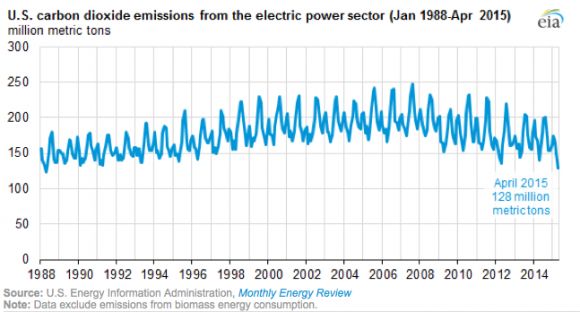Carbon dioxide emissions produced by the U.S. electric power sector hit a 27-year low in April, the lowest amount for any month since April 1988, according to new figures from the U.S. Energy Information Administration.
The finding comes days after the EPA finalized the Clean Power Plan, a landmark regulation that aims to accelerate carbon cuts from existing power plants, to achieve a 32 percent industry-wide reduction by 2030.
Carbon dioxide emissions from the electric power sector already fell by 15 percent between 2005 and 2013, stemming from slower economic activity during the 2008 recession, the substitution of the less-carbon-intensive natural gas for coal and petroleum, and growth in non-carbon generation, especially renewables such as wind and solar.
The Clean Power Plan calls for reducing emissions another 17 percent between 2013 and 2030.

April is typically the least polluting month for the power industry, because of reduced demand for heating and cooling in the spring. This year, both coal and natural gas fell from their March values -- 18 percent and 6 percent, respectively.
The greater drop in coal generation, which produces 71 percent to 79 percent more carbon dioxide emissions than natural gas, was largely responsible for the overall decline in power sector emissions. It also caused electricity generation from natural gas to surpass coal generation for the first time since the EIA started collecting data in 1973.
The switch only lasted for one month, however. On an annual average basis, coal has lost generation share to natural gas and, increasingly, renewables, but it is expected to remain the dominant source of electricity generation through 2015. How much of the electricity mix each fuel type makes up going forward will depend on how much each fuel costs, as well as overall levels of electricity demand.
Looking at historical trends, it seems unlikely that coal will remain king for much longer. Between April 1988 to April 2015 natural-gas consumption in the electricity sector more than tripled, renewable energy consumption more than doubled, nuclear energy consumption increased 47 percent, and coal consumption decreased 17 percent, according to the EIA.
Defending against the "war on coal"
Critics have said the emissions reductions expected under the Clean Power Plan amount to a “war on coal.” The Obama administration has insisted that while the rule is ambitious, it follows market trends that existed well before the current president took office. (This is also causing some to question how ambitious the new carbon rules really are.)
Peabody Energy, the world’s largest private-sector coal company, strongly urged the courts, Congress, states, consumer groups and electricity customers to oppose the rule. According to Peabody and its allies, the rule would curb the use of low-cost coal at a time of rising electricity rates, putting America’s tepid economic growth at risk.
Republicans in Congress already have several legislative attacks on the climate rule underway. On Wednesday, the Senate Environment and Public Works Committee marked up and passed S. 1324, the “Affordable Reliable Electricity Now Act of 2015.” The bill blocks implementation of the Clean Power Plan and allows states to opt out of complying with any future plan.
“It shocks me that this Committee -- the Environment Committee -- could lead the charge against a clean and healthy environment. It doesn’t make any sense,” said Senator Barbara Boxer (D-Calif.), EPW Ranking Member, in her opening statement on the legislation. “These bills may be reported today, but I expect strong opposition on the Senate floor.”
This bill won’t be the only attack. James Inhofe (R-Okla.), chairman of the EPW Committee, is also preparing two Congressional Review Act disapproval resolutions to invalidate the regulation. The resolutions are still subject to presidential veto, so Inhofe would have to gather more than 50 Senate votes for them to pass. Inhofe told E&E News he is taking an “all-of-the-above” approach to tearing down the rule, adding that an appropriations rider would be “a good bet.”
At the state level, the Electric Reliability Coordinating Council (ERCC) claims that more than 25 states are aggressively supporting pushback on the rule through their governors and attorneys general. At least some of these states are expected to launch a lawsuit against the EPA in the coming weeks.
“The final rule does very little to change the central thrust of the legal objections,” said Scott Segal, director of the ERCC. “The weakest part of the EPA proposal is that the agency is attempting to use the Clean Air Act to regulate far afield from the actual facilities that are the target of the rule. In the parlance of the rule, that's called 'going beyond the fence line.'”
“By dropping consumer energy efficiency as a basis for establishing the rule, the EPA has removed one part of the rule that lies beyond the fence line,” he continued, referring to the elimination of building block 4 in the final rule. “But changing the dispatch of natural gas and insisting on renewables investment really lie just as far outside the fence line. “
Meanwhile, a new survey from Public Policy Polling, a firm that often works with Democratic clients, indicates that a majority of voters in key swing states support the Clean Power Plan and think negatively of elected officials who oppose it.
When asked if they agree with Mitch McConnell's urging the states to ignore the EPA and not develop a plan to cut carbon pollution, only 31 percent of respondents said yes, while 59 percent said that states should move forward with the implementation of a plan.
For (nearly) everything you need to know about the Clean Power Plan, listen to this week's Energy Gang podcast:


